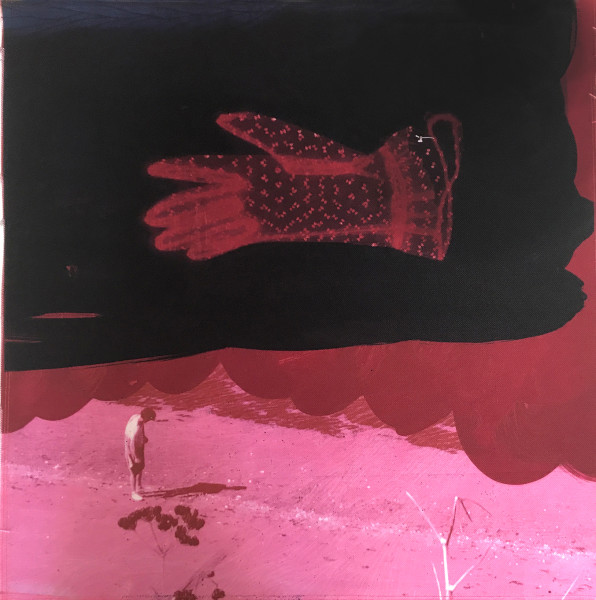Thanetian Glove (2020.13)
Catalogue Record
Collection
Maker
Shelly Goldsmith
Title
Thanetian Glove
Made in
Ramsgate
Date
2019
Description
Digital & hand dye sublimated textile prints on second-use polyester cloth with minor elements of stitch. In two parts.
Materials and techniques
The piece ‘Thanetian Glove’ uses digital and hand dye sublimation on second use polyester cloth, with minor elements of stitch.
Dye sublimation is a process where solid dispersal dye is turned into vapor under extreme heat and pressure, the dye on the paper transfers from the paper onto the surface of the cloth where there is contact. Dye should be exhausted off the paper.
In this piece,
• the digital dye sublimation uses a photograph of the Walpole Bay tidal pool, the colour is changed in photoshop. Using a specialist Mimaki JV300-130 Printer it prints the photographic image using dispersal dye onto paper, ready to be sublimated using a large format heated roller press.
• the hand dye sublimation methods use liquid dispersal dye to paint over the digitally printed paper before sublimation.
• Objects, glove and net, are used as stencils during the sublimation process, masking the dye from the cloth and creating an unprinted area in the shape of the stencil, the glove etc. In this piece, where the the net has more bulk it inhibits contact between the cloth and the dyed paper during sublimation and a halo effect is created in this area.
• Stitching is added to the piece. A hand stitched line (3 twisted silk threads of different colours) is stitched onto the printed cloth (after printing) to mirror the shape in the stencilled net image.
Two lines of white polyester machine stitching are stitched to the white cloth before printing. These are dyed through the process of dyes sublimation and as they are partially unpicked, the white cloth and white thread is revealed.
Dye sublimation is a process where solid dispersal dye is turned into vapor under extreme heat and pressure, the dye on the paper transfers from the paper onto the surface of the cloth where there is contact. Dye should be exhausted off the paper.
In this piece,
• the digital dye sublimation uses a photograph of the Walpole Bay tidal pool, the colour is changed in photoshop. Using a specialist Mimaki JV300-130 Printer it prints the photographic image using dispersal dye onto paper, ready to be sublimated using a large format heated roller press.
• the hand dye sublimation methods use liquid dispersal dye to paint over the digitally printed paper before sublimation.
• Objects, glove and net, are used as stencils during the sublimation process, masking the dye from the cloth and creating an unprinted area in the shape of the stencil, the glove etc. In this piece, where the the net has more bulk it inhibits contact between the cloth and the dyed paper during sublimation and a halo effect is created in this area.
• Stitching is added to the piece. A hand stitched line (3 twisted silk threads of different colours) is stitched onto the printed cloth (after printing) to mirror the shape in the stencilled net image.
Two lines of white polyester machine stitching are stitched to the white cloth before printing. These are dyed through the process of dyes sublimation and as they are partially unpicked, the white cloth and white thread is revealed.
Dimensions
width: 48.5cm
height: 48.5cm
height: 58cm
width: 46.5cm
Object number
2020.13
Category
Maker's statement
The piece is part of a larger body of work that has been a primary investigation at part of my post as Reader in Textiles at the University for the Creative Arts. . It demonstrates the key themes and techniques I currently research and have used /pioneered within my practice and which formed the basis of my approach from the last 10 years. The Locus of the Dress, body of work (but not including this piece) has been exhibited extensively internationally, featured in magazines and books and received special commendations most recently in the Vlieseline Fine Art Textile Award
[I was inspired by] Locus of Control theory by J Rotter.
Locus of control is the degree to which people believe that they, as opposed to external forces (beyond their influence), have control over the outcome of events in their lives. The concept was developed by Julian Rotter in 1954, and has since become an aspect of personality studies. A person's ‘locus’ (plural "loci", Latin for "place" or "location") is conceptualised as internal (a belief that one can control one's own life) or external (a belief that life is controlled by outside factors which the person cannot influence, or that chance or fate controls their lives).
Ref: Rotter, Julian B (1966). "Generalized expectancies for internal versus external control of reinforcement". Psychological Monographs: General and Applied. 80: 1–28.
[I was inspired by] Locus of Control theory by J Rotter.
Locus of control is the degree to which people believe that they, as opposed to external forces (beyond their influence), have control over the outcome of events in their lives. The concept was developed by Julian Rotter in 1954, and has since become an aspect of personality studies. A person's ‘locus’ (plural "loci", Latin for "place" or "location") is conceptualised as internal (a belief that one can control one's own life) or external (a belief that life is controlled by outside factors which the person cannot influence, or that chance or fate controls their lives).
Ref: Rotter, Julian B (1966). "Generalized expectancies for internal versus external control of reinforcement". Psychological Monographs: General and Applied. 80: 1–28.






